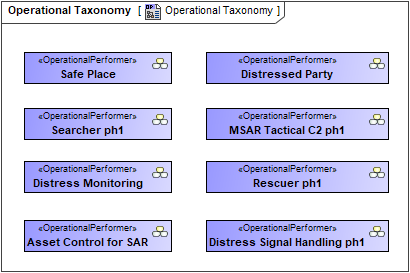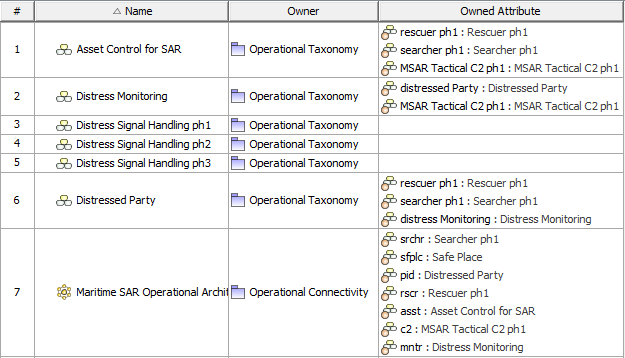Description
The Operational Taxonomy (Op-Tx) shows the main Operational Performers of the architectural scenario. It also illustrates the flows of information and materiel between these Operational Performers specified in the Operational Information model.
The Operational High Level Taxonomy diagram illustrates the primary scenario for which the architecture is intended.
Implementation
The Operational Taxonomy (Op-Tx) view is represented by:
- Operational Taxonomy diagram. The primary purpose of the Operational Taxonomy diagram is to define capability requirements within an operational context. It may also be used to express a capability boundary. The Operational Taxonomy diagram can be used to show flows of funding, personnel and materiel in addition to information.
The intended usage of the Operational Taxonomy diagram includes:
- Definition of operational concepts.
- Elaboration of capability requirements.
- Definition of collaboration needs.
- Applying a local context to a capability.
- Problem space definition.
- Operational planning.
- Supply chain analysis.
- Allocation of activities to resources.
- Operational Taxonomy table. This table can be used to create and describe major domain elements faster.
- Operational High Level Taxonomy diagram. It describes a mission, class of mission, or scenario and shows the main operational concepts and interesting or unique aspects of operations. With a help of a Operational High Level Taxonomy diagram you can describe the interactions between the subject architecture and its environment, and between the architecture and external systems.
The intended usage of the Operational High Level Taxonomy diagram includes:
- Putting an operational situation or scenario into context.
- Providing a tool for discussion and presentation; for example, aids industry engagement in acquisition.
- Providing an aggregate illustration of the details within the published high-level organization of more detailed information in published architectures.
- Operational Free Form Taxonomy diagram. This diagram can be used alternatively to Operational High Level Taxonomy diagram.
Sample
An example of the Operational High Level Taxonomy diagram
An example of the Operational Taxonomy diagram
An example of the Operational Taxonomy Table
Related elements
- Asset
- Capability Configuration
- Concept Item
- High Level Operational Concept
- Geo Political Extent Type
- Location
- Natural Resource
- Operational Agent
- Operational Performer
- Organization
- Organizational Resource
- Post
- Physical Resource
- Resource Architecture
- Resource Artifact
- Resource Performer
- Software
Related diagrams


